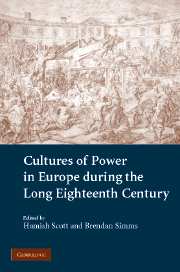Book contents
- Frontmatter
- Contents
- Preface
- List of contributors
- 1 Introduction: culture and power during the long eighteenth century
- 2 When culture meets power: the Prussian coronation of 1701
- 3 Military culture in the Reich, c. 1680–1806
- 4 Diplomatic culture in old regime Europe
- 5 Early eighteenth-century Britain as a confessional state
- 6 ‘Ministers of Europe’: British strategic culture, 1714–1760
- 7 Confessional power and the power of confession: concealing and revealing the faith in Alpine Salzburg, 1730–1734
- 8 The transformation of the Aufklärung: from the idea of power to the power of ideas
- 9 Culture and Bürgerlichkeit in eighteenth-century Germany
- 10 The politics of language and the languages of politics: Latin and the vernaculars in eighteenth-century Hungary
- 11 ‘Silence, respect obedience’: political culture in Louis XV's France
- 12 Joseph II, petitions and the public sphere
- 13 The court nobility and the origins of the French Revolution
- 14 The French Revolution and the abolition of nobility
- 15 Foreign policy and political culture in later eighteenth-century France
- 16 Power and patronage in Mozart's La clemenza di Tito and Die Zauberflöte
- 17 Between Louis and Ludwig: from the culture of French power to the power of German culture, c. 1789–1848
- Index
2 - When culture meets power: the Prussian coronation of 1701
Published online by Cambridge University Press: 17 July 2009
- Frontmatter
- Contents
- Preface
- List of contributors
- 1 Introduction: culture and power during the long eighteenth century
- 2 When culture meets power: the Prussian coronation of 1701
- 3 Military culture in the Reich, c. 1680–1806
- 4 Diplomatic culture in old regime Europe
- 5 Early eighteenth-century Britain as a confessional state
- 6 ‘Ministers of Europe’: British strategic culture, 1714–1760
- 7 Confessional power and the power of confession: concealing and revealing the faith in Alpine Salzburg, 1730–1734
- 8 The transformation of the Aufklärung: from the idea of power to the power of ideas
- 9 Culture and Bürgerlichkeit in eighteenth-century Germany
- 10 The politics of language and the languages of politics: Latin and the vernaculars in eighteenth-century Hungary
- 11 ‘Silence, respect obedience’: political culture in Louis XV's France
- 12 Joseph II, petitions and the public sphere
- 13 The court nobility and the origins of the French Revolution
- 14 The French Revolution and the abolition of nobility
- 15 Foreign policy and political culture in later eighteenth-century France
- 16 Power and patronage in Mozart's La clemenza di Tito and Die Zauberflöte
- 17 Between Louis and Ludwig: from the culture of French power to the power of German culture, c. 1789–1848
- Index
Summary
On 18 January 1701, Frederick III, Elector of Brandenburg and Duke of Prussia, was crowned ‘King in Prussia’ in the city of Königsberg. The splendour of the event was unprecedented in the history of the House of Hohenzollern. According to one contemporary report, 30,000 horses were required to relay the Electoral family, their retainers and their luggage, all packed into 1,800 carriages, along the road to the place of coronation. The ceremony itself began on the morning of 18 January in the audience chamber of the Elector, where a throne had been erected specially for the occasion. Dressed in a scarlet and gold coat glittering with diamond buttons and a crimson mantle with an ermine lining and attended by a small gathering of male family members, courtiers and senior local officials, the Elector placed the crown on his own head, took his sceptre in hand and received the homage of those present.
He then passed into the chambers of his wife, whom he crowned as his queen in the presence of their household. After representatives of the Estates had rendered homage, the royal couple processed to the castle chapel in order to be anointed. Here they were greeted at the entrance by two bishops, one Lutheran and one Reformed (Calvinist), both of whom had been appointed to their offices specifically for this purpose – in deference to the bi-confessional character of the Brandenburg-Prussian state (in which a Calvinist dynasty ruled over a population of Lutheran subjects).
- Type
- Chapter
- Information
- Publisher: Cambridge University PressPrint publication year: 2007
- 4
- Cited by



